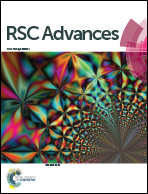Preparation and characterization of nano-sized PS@Pd core–shell architectures with a one-pot method
Abstract
Monodispersed and nano-sized Pd (palladium) coated PS (polystyrene) core–shell architectures have been prepared successfully by a facile, green and fast one-pot method, in which an acrylic acid and vitamin C were used for the carboxyl-functionalization of the polymer beads and as a reducing agent, respectively. The structures and morphologies of the PS@Pd core–shell architectures were characterized by X-ray diffraction (XRD), transmission (high resolution) electron microscopy (TEM, HRTEM), X-ray photoelectron spectroscopy (XPS) and so on. The results demonstrated that the Pd nanoparticles were deposited on the surface of the PS sphere beads, and the Pd nanoparticles were homogeneous and monodispersed. The results also indicated that the diameter of the Pd shell was 5 ± 1.2 nm and the PS@Pd core–shell architectures were 80 ± 3.5 nm. So this one-pot preparation method provides developmental direction to fabricate all kinds of polymer@nonmetal core–shell architectures. In addition, the PS@Pd showed improved electrocatalytic activity for formic acid oxidation in comparison with commercial Pd nanoparticles through controlling the surface structures.


 Please wait while we load your content...
Please wait while we load your content...